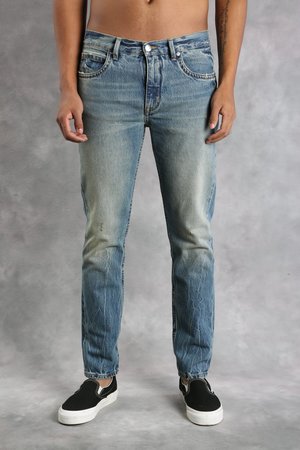What is Tinting in Textile?
Tinting of denim is an additional dyeing treatment normally carried out on jeans after they are sewn. It is also called overdyeing. This adds another color to the jeans. Normally denim garments are overdyed with yellowish dye to appear dirty.
Tinting of denim garments is usually done after the stone wash process. In this procedure, the garment is lightly colored to give the final denim appearance a slight shift. This is not true overdyeing but merely gives the impression of a change in the overall color of the fabric. This process consumes a large quantity of water and chemicals. To make this process economical and ecologically friendly, some novel color-based enzymes were introduced to the market.

Tinting is a process where very less amount of tint is involved and mainly direct dye is being used to do this process. This is being done to change hue/cast/tone of indigo. As soon as quantity of tint color increases and it cover up indigo, reaches the level of dyeing.
Tinting being used to give garments a used / vintage and muddy look. This process takes from 5 minutes to 25 minutes time for better results followed by dye fixing and clean up of superficial dye.
You may also like: Acid Washing Process of Denim Jeans
Tinting or overdyeing is being done on very light shade of Indigo, Ecru/ grey denim and Ready for dyeing denim. Various types of dyes are used for overdyeing and tinting:
The comparison of these dyes is given in the chart here below:
- Direct Dyes
- Reactive Dyes
- Pigment Dyes
- Sulphur Dyes
Flow Chart of Tinting Process of Denim Garments:
The basic steps of tinting of denim garments are given below.
Desizing
↓
Bleach washing/enzyme washing
↓
Tinting
↓
Rinsing (25 °C, 2 min)
↓
Colour fixing
↓
Rinsing (25 °C, 2 min)
↓
Softening
↓
Hydroextracting
↓
Drying.
Tinting with direct dye:
- Direct dye ————————-× g/L
- Salt ——————————–3 g/L
- Temperature ———————60°C
- Time ——————————-6 min
Tinting with sulphur dye:
- Sulphur dye ———————–× g/L
- Sodium sulphide—————– 0.85 × g/L
- Temperature ———————-90–95°C
- Time ——————————-20–30 min
Tinting of Denim Garments without Changing Indigo Tone:
Tinting is achieved by application of the direct/reactive dyes. In case of direct dyes, the second application would be that of dye-fixing agent for an adequate fastness. In case of reactives, the fixing chemical goes along with the dyestuff. After the application, the treated garment is dried in the air or in a tumble drier for adequate fastness. If tinting were done by immersion method, the tint would be all over. However, if a localized area is the target, a spray method is used. In either case the tinting, as the term signifies, is done very lightly to achieve a particular cast, either overall or localized. If indigo does not change tone would look like a print with a sharp boundary. When tone changes fad gradient, the effect looks more aesthetically appealing and is considered desirable. The tone-change should be gradual and not abruptive.
Tinting with White Discharge Effect on Denim Garments:
The standard route to blasting / discharging / tinting is quite elaborate, in the light of three effects to be imparted on the same garment. There have been short cuts, which may be right/wrong/ingenious. If tinting is done on blasted/discharged areas, it obviously remains a spray method. However, if the tinting is overall, it follows the dyeing route. The process starts on gray garment being hand blasted followed by desizing and biopolishing. After drying the garment, tint-spray is given followed by air/machine drying and finishing. For tinting by dyeing method, the biopolished garment can straight away go for tinting wet-on-wet followed by finishing and drying.
In case of white discharge tinting the route would start with desizing-biopolishing on gray garment, peroxide bleaching after biopolishing being optional. After drying the garment, a potassium permanganate spray is given to areas where white discharge is aimed at. After air-drying for about 10-15 minutes, a neutralization step consisting of provide-acetic acid is given which is followed by hot and cold rinses. In case of spray tinting the garment will have to be dried first, whereas for overall tinting, dyeing the method could be followed wet-on-wet. Finally the finishing and drying would complete the process.
You may also like: Step by Step Bleach Wash Process in Garments
